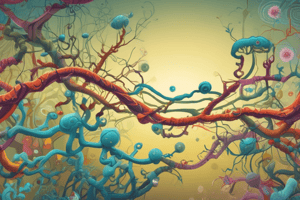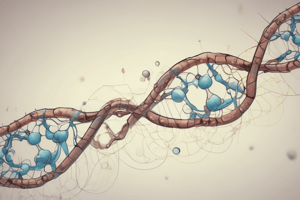Podcast
Questions and Answers
During which stage of the cell division process does DNA replication occur?
During which stage of the cell division process does DNA replication occur?
- G2 phase
- S phase (correct)
- G1 phase
- M phase
Which model of DNA replication suggested that only one strand of DNA is copied during the process?
Which model of DNA replication suggested that only one strand of DNA is copied during the process?
- Conservative Model
- Watson and Crick Model
- Semiconservative Model (correct)
- Dispersive Model
Who conducted the experiment in 1957 that demonstrated DNA replicates via a semiconservative mechanism called 'Density Shift'?
Who conducted the experiment in 1957 that demonstrated DNA replicates via a semiconservative mechanism called 'Density Shift'?
- Watson and Crick
- Matthew Meselson and Franklin Stahl (correct)
- Gregor Mendel
- Rosalind Franklin
What is the final step in the Central Dogma where amino acids are coded into proteins?
What is the final step in the Central Dogma where amino acids are coded into proteins?
Which of the following models of DNA replication suggests that both strands of DNA are duplicated during the process?
Which of the following models of DNA replication suggests that both strands of DNA are duplicated during the process?
What must a parental cell do before dividing?
What must a parental cell do before dividing?
What structure is formed when the DNA double helix is opened at the origins of replication?
What structure is formed when the DNA double helix is opened at the origins of replication?
In which direction is the leading strand synthesized during DNA replication?
In which direction is the leading strand synthesized during DNA replication?
What is the role of Transcription Factors in transcription?
What is the role of Transcription Factors in transcription?
What is the main difference between the leading and lagging strands during DNA replication?
What is the main difference between the leading and lagging strands during DNA replication?
Which step in gene expression involves creating a messenger RNA from a DNA template?
Which step in gene expression involves creating a messenger RNA from a DNA template?
What initiates the formation of replication forks during DNA replication?
What initiates the formation of replication forks during DNA replication?
What is the key difference between the Coding Strand and the Sense Strand in RNA synthesis?
What is the key difference between the Coding Strand and the Sense Strand in RNA synthesis?
What is the role of the Antisense Strand in RNA synthesis?
What is the role of the Antisense Strand in RNA synthesis?
Which enzyme catalyzes the process of transcription?
Which enzyme catalyzes the process of transcription?
What is the function of the TATA box in transcription initiation?
What is the function of the TATA box in transcription initiation?
Which step in transcription involves unwinding of the DNA double helix?
Which step in transcription involves unwinding of the DNA double helix?
What indicates where a gene's RNA-encoding region ends in DNA?
What indicates where a gene's RNA-encoding region ends in DNA?
What is the primary function of chaperone proteins in protein folding?
What is the primary function of chaperone proteins in protein folding?
Where do misfolded proteins go when they are tagged with ubiquitin?
Where do misfolded proteins go when they are tagged with ubiquitin?
What happens to a protein with more than one tag after misfolding?
What happens to a protein with more than one tag after misfolding?
Which organelle acts as a tunnel-like multiprotein structure for degrading misfolded proteins?
Which organelle acts as a tunnel-like multiprotein structure for degrading misfolded proteins?
When do proteins start to fold after being synthesized?
When do proteins start to fold after being synthesized?
What is the role of the third tRNA in protein synthesis?
What is the role of the third tRNA in protein synthesis?
What is the function of the protein release factor in translation termination?
What is the function of the protein release factor in translation termination?
What happens to amino acids after translation in protein synthesis?
What happens to amino acids after translation in protein synthesis?
Which protein structure level refers to amino acid sequence getting close together to form loops, coils, barrels, helices, and sheets?
Which protein structure level refers to amino acid sequence getting close together to form loops, coils, barrels, helices, and sheets?
In protein folding, what creates the 3-D illusion of the protein structure?
In protein folding, what creates the 3-D illusion of the protein structure?
Study Notes
DNA Replication
- DNA replication occurs at the origins of replication, where the double helix is unwound on both sides to form replication forks.
- Replication forks are the site where single-stranded DNA is exposed and DNA synthesis occurs.
- DNA replication can be bidirectional, with replication forks forming at either end of the bubble.
- The leading strand is always synthesized in the 5’ to 3’ direction.
- The lagging strand is replicated discontinuously as fragments, which are later joined to form a continuous strand.
Gene Expression
- The human genome encodes proteins, and genes encode 20,325 types of proteins.
- Gene expression requires several steps: transcription, translation, and protein synthesis.
- Transcription is the process of creating a messenger RNA that copies the DNA template that encodes a certain type of protein.
- Transcription factors are essential in transcription, as they interact and form an apparatus that binds DNA at certain sequences, initiate transcription, respond to signals from outside the cell, and link the genome to the environment.
The Central Dogma
- The Central Dogma is a theory that genetic information flows only in one direction, from DNA to RNA to protein, or RNA directly to protein.
- The Central Dogma is divided into three major parts: replication, transcription, and translation.
- The last step involves protein synthesis, in which amino acids are coded into proteins and their structure.
DNA Replication Hypothesis
- Three models of DNA replication were proposed: Semiconservative, Conservative, and Dispersive.
- The Semiconservative Model was demonstrated to be the correct mechanism by Matthew Meselson and Franklin Stahl in 1957 through the "Density Shift" experiment.
RNA Synthesis
- In transcription, the coding strand sequence is the same as the RNA sequence produced, except for Uracil replacing Thymine.
- The sense strand is the RNA sequence used to determine which amino acids are produced through mRNA.
- The template strand is the strand used for RNA synthesis of a particular RNA product.
- The antisense strand is the code complementary to the RNA produced.
Transcription
- Transcription is described in three steps: initiation, elongation, and termination.
- In transcription initiation, the binding of DNA polymerase to the promoter region occurs, which is recognized by the TATA binding protein.
- The TATA binding protein forms a pocket that allows RNA polymerase to bind and begin making RNA.
Protein Synthesis
- In translation, amino acids are formed from the instructions on the DNA.
- Proteins are classified into four basic structures or levels: primary, secondary, tertiary, and quaternary.
- Proteins fold into one or more three-dimensional shapes or conformations through folding, which is affected by attractions and repulsions between components.
Protein Structure and Folding
- Primary structure refers to the basic amino acid sequence.
- Secondary structure refers to amino acid sequences getting close together due to chemical reactions, forming loops, coils, barrels, helices, and sheets.
- Tertiary structure refers to larger structures formed from secondary structure, shaped by bonds between the R groups and their interaction with water.
- Quaternary structure consists of more than one polypeptide chain formed by bonds between several polypeptides.
- Chaperone proteins assist in precise protein folding by stabilizing partially folded regions and preventing proteins from getting stuck.
- Misfolded proteins can be degraded back into amino acids through the ubiquitin-proteasome pathway.
Studying That Suits You
Use AI to generate personalized quizzes and flashcards to suit your learning preferences.
Description
Test your knowledge on the different features of RNA synthesis in transcription, including Coding Strand, Sense Strand, Template Strand, and Antisense Strand. Understand the role of each strand in the process of RNA production.



